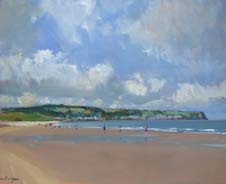Seeing Order in Chaos: Randomness and chance in art
Malcolm Ludvigsen

- Friday 13 June 2014, 6.30PM to 8.30pm
- Free admission
Booking required
Book tickets - Room AEW/003, Alcuin East Wing (map)
Event details
![]()
Randomness and chance seem to play an important role in art, particularly painting and drawing. An oil painting, when looked at closely, appears to be nothing but a random collection of coloured marks, but these resolve themselves into an image as we move away from the painting. It is this very randomness which sometimes gives the painting life and distinguishes it from a photograph, though the random element may not be visible to the viewer.
The artist achieves this by clever brushwork or by starting with a random pattern and them seeing the image in the chaos of marks, a method actually recommended by Leonardo da Vinci. Some of the best examples of this are from early cave art where the artist has seen the image, for example a horse, in the cracks and stains of the rock and then simply emphasised them. Another source of randomness is the so-called happy accident, where a slip of the brush produces a random but interesting mark.
In this illustrated talk, artists and mathematician, Malcolm Ludvigsen, will discuss the random and chaotic element in art from the point of view of both a scientist and a painter. In particular we shall take a sceptical look at the possible use of the concept of entropy in art, and whether fractals and so-called chaos theory can play useful and meaningful role.
About the speaker
Malcolm Ludvigsen is a plein-air oil painter best known for his Yorkshire seascapes and beach scenes. He believes that working outside, directly in front of the subject, gives his work a life and vibrancy lacking in much of studio work. His paintings can be seen in homes and galleries throughout the UK and the USA - and many other places too. In 2013 he won the Oldie, £5000, British Art Award.
As well as being a painter, Malcolm Ludvigsen is also a professor of mathematics, specialising in relativity and cosmology. About 10 years ago he took a sabbatical and started painting for fun. He thinks the thing that first attracted him was John Ruskin's exhortation that all men, as part of their morning salutations, should go out and paint a picture of the sky. This sounded like a very nice thing to do, so he decided to give it a go, and he has not really stopped painting since.
His professorship is from the University of Linkoping in Sweden where he worked for several years. He also does some teaching at the University of York. His research work deals mostly with black holes, gravitational radiation and cosmology. He is the author of quite a well-known book called General Relativity: A Geometric Approach, published by Cambridge University Press (also available in a French translation with a preface by Sir Roger Penrose). He finds little incompatibility between his mathematical work and his painting: both are based on geometrical intuition, one internal the other external. Malcolm lives and works in York.
Please note this talk is being held in Alcuin East Wing and not the Harry Fairhurst building as previously advertised.
![]()
Accessibility
Wheelchair accessible
You may also like...
This event is part of the Arts and Society: Order, Chaos and Culture festival theme. Also in this theme:

